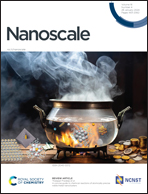Gap-enhanced optical bistability in plasmonic core–nonlinear shell dimers†
Abstract
Localized surface plasmon resonance in capacitively-coupled metallic nanoparticle dimers accompanied by a substantial local field enhancement in the interparticle gap area can enable boosting of nonlinear optical effects. In this paper, we analyze optical bistability in a plasmonic spherical dimer wrapped by a mutual nonlinear shell. In the common graphical post-processing technique of optical bistability, it is assumed that the refractive index change is homogeneous throughout the whole shell. However, we resolve this issue by taking into account the inhomogeneous nature of the power density in the dimer and linking the refractive index change to the local intensity inside the shell. The hysteresis branches of the normalized scattering and extinction cross-sections, as well as electric near-field strength, were derived by increasing and decreasing the driving field intensity. The analysis shows that optical bistability in the dimer with a 3 nm gap can be achieved at switching intensities of about 375 kW cm−2 and 225 kW cm−2, where each stable state of the C-Sh dimer corresponds to a certain plasmonic mode. The range of driving field intensities can be further decreased by considering smaller interparticle distances. The influence of the nonlinear shell on the spectral response is also examined. Suggested configurations distributed on a planar dielectric substrate have potential applications as all-optical switches and memory elements.



 Please wait while we load your content...
Please wait while we load your content...